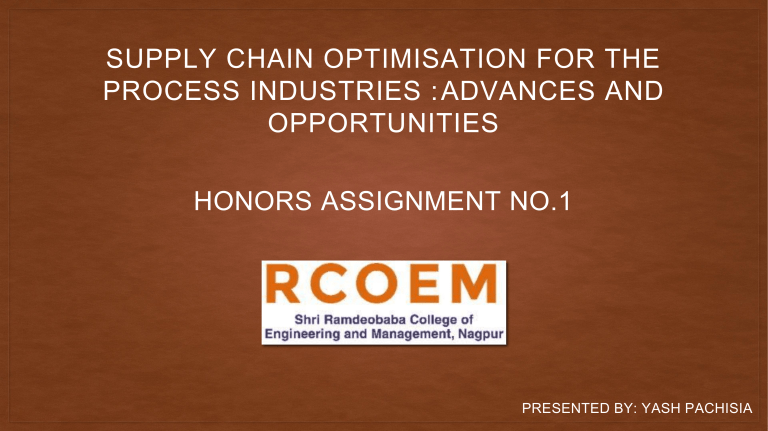
SUPPLY CHAIN OPTIMISATION FOR THE PROCESS INDUSTRIES : ADVANCES AND OPPORTUNITIES HONORS ASSIGNMENT NO.1 PRESENTED BY: YASH PACHISIA CONTENT • Abstract • Introduction • Literature Review • Mathematical Formation • Computational Experiment • Conclusion ABSTRACT Supply chain management operates at three levels, strategic, tactical and operational. While the strategic approach generally pertains to the optimisation of network resources such as designing networks, location and determination of the number of facilities, etc., tactical decisions deal with the mid-term, including production levels at all plants, assembly policy, inventory levels and lot sizes, and operational decisions are related to how to make the tactical decisions happen in the short term, such as production planning and scheduling. This paper mainly discusses and explores how to optimise strategic and tactical decisions together in the supply chain. A nonlinear mixed-integer model is developed to minimise the total costs and the number of assembly stations while minimising the total fixed costs. INTRODUCTION Supply chain management is more than just innovation for the sake of being innovative. It creates a unique supply chain configuration that drives objectives forward. Five critical .configuration components are needed for consideration under strategic, tactical and operational decisions to get the most from a supply chain. • operations strategy • outsourcing strategy • channel strategy • customer service strategy • asset network LITERATURE REVIEW During the last several decades, supply chain management has received considerable attention from academicians, researchers and operators. Designing and optimising SCNs is one of the most prevalent problems in this research field. For that reason, many mathematical and heuristic models have been proposed. Most of these models are related to transportation/distribution networks with the following considerations. • location of the facilities (plants, distribution centres, etc.) to be opened; • design of the network configuration; and • satisfy customer demand by minimising the total cost, including purchasing, transportation, fixed operating costs, etc. MODEL OPTIMISATION OF SUPPLY CHAIN NETWORKS WITH ASSEMBLY LINES A nonlinear mixed-integer model is developed to solve the optimisation problem of a supply chain network with assembly lines. A typical supply chain network design problem has standard inputs such as a set of customer zones to serve, a group of products to be manufactured and distributed, demand projections for the different customer zones, and information concerning future conditions, costs (e.g., for production and transportation) and resources (e.g., capacities, available raw materials). To consider this relation, we embedded the assembly line balancing problem into a supply chain network design problem. We determined the cycle time (CT) as the integration point of these two problems. BASIC ASSUMPTIONS OF MODEL MATHEMATICAL MODEL COMPUTATIONAL EXPERIMENT The application of the model is performed for a hypothetical data set. The considered supply chain includes four manufacturers, two assemblers and four customers. While determining the transportation amounts between manufacturers, assemblers and customers, the model also attempts to balance the assembly lines in assemblers simultaneously. The model tries to find how many products will be transported from assemblers to customers in addition to balancing the assembly lines according to the cycle time under fixed costs. RESULT Cycle Time Network Diagram Scenarios CONCLUSION This paper addresses an important issue concerning applying strategic and tactical decisions in supply chain management. The main objective of this paper is to introduce and characterise the problem of integrating supply chain network design and assembly line balancing issues. For this purpose, in this paper, a novel nonlinear mixed-integer programming formulation is developed to model and solve the problem. The proposed mathematical model considers the optimum distribution network while balancing the assembly lines in each assembler simultaneously






